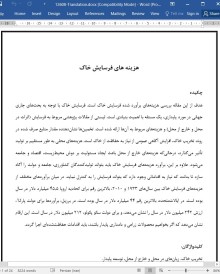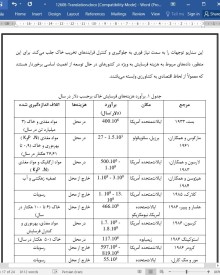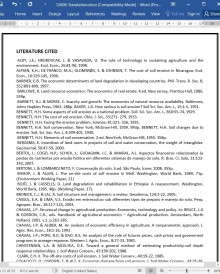
دانلود مقاله هزینه های فرسایش خاک
چکیده
هدف از این مقاله بررسی هزینههای برآورد شده فرسایش خاک است. فرسایش خاک با توجه به بحثهای جاری جهانی در مورد پایداری، یک مسئله با اهمیت بنیادی است. لیستی از مقالات پژوهشی مربوط به فرسایش (اثرات در محل و خارج از محل) و هزینههای مربوط به آنها ارائه شده است. تخمینها نشاندهنده مقدار منابع صرف شده در روند تخریب خاک، افزایش آگاهی عمومی از نیاز به حفاظت از خاک است. هزینههای محلی به طور مستقیم بر تولید تأثیر میگذارد، درحالیکه هزینههای خارج از محل باعث ایجاد مسئولیت بر دوش محیطزیست، اقتصاد و جامعه میشود. علاوه بر این، برآورد هزینههای فرسایش خاک باید بتواند تولیدکنندگان کشاورزی، جامعه و دولت را آگاه سازد تا بدانند که نیاز به اقداماتی وجود دارد که بتواند فرسایش را به کنترل نماید. در میان برآوردهای مختلف از هزینههای فرسایش خاک بین سالهای 1933 و 2010، بالاترین رقم برای اتحادیه اروپا 45.5 میلیارد دلار در سال بوده است. در ایالاتمتحده، بالاترین رقم 44 میلیارد دلار در سال بوده است. در برزیل، برآوردها برای دولت پارانا ، ارزش 242 میلیون دلار در سال را نشان میدهد، و برای دولت سائو پائولو، 212 میلیون دلار در سال است. این ارقام نشان میدهد که اگر بخواهیم محصولات زراعی و دامداری پایدار باشند، باید اقدامات حفاظتشدهای اجرا گردد.
مقدمه
فرسایش خاک تنها یک مشکل کشاورزی نیست بلکه با مسائل زیستمحیطی، اجتماعی و اقتصادی ارتباط دارد. همچنین اذعان شده است که فرسایش خاک یک مانع بزرگ برای امنیت غذایی و یک مشکل جدی برای توسعه پایدار است.
خاک توسط آب و باد تخریب میشود؛ بدین صورت که ذرات خاک را تجزیه و پراکنده میکنند (میلر، 1931؛ بنت، 1955؛ فوث، 1990). یکی از عواملی که این فرایند را تقویت میکند، مدیریت نامناسب خاک است؛ یعنی فعالیتهای انسانی که در مطالعات متعددی از جمله بنت (1929)، الیسون (1948)، لال (1997) و برتونی و لامباردی نتو (2008) ارائه شده است. فرسایش آب بیشترین تأثیر را بر زمین دارد که نتیجه بارش باران و رواناب سطحی است و عمدتاً تحت تأثیر سیستمهای مدیریت زراعتی میباشد (زاچار، 1982). فرسایش باعث تغییر خواص شیمیایی، خواص فیزیكی و بیولوژیکی خاک میشود، حاصلخیزی خاک را کاهش میدهد و به عنوان یک نتیجه مستقیم، بهرهوری خاک را کم میکند (پیمنتل و همکاران، 1995؛ لال، 2000، 2006؛ مورگان، 2005) كه موجب ایجاد نگرانی در میان كارشناسان در زمینههای مختلف مربوط به تلفات و هزینهها میگردد.
هزینهها براساس اثرات در محل (تلفات در واحد تولیدی) و اثرات خارج از محل (آسیب فراتر از زمین کشاورزی) محاسبه میشود. در ایالاتمتحده، هزینه سالانه فرسایش خاک ناشی از اثرات در محل و خارج از محل حدود 44 میلیارد دلار در سال تخمین زده شده است (پیمنتل و همکاران، 1995). در اتحادیه اروپا، این رقم 38 میلیارد یورو در سال است (مونتانارلا، 2007).
ملاحظات نهایی
علاوه بر زیانهای فیزیکی، شیمیایی و بیولوژیکی، فرسایش خاک باعث زیانهای اقتصادی میشود که میتوان آن از نظر هزینههای تحمیل شده به کشاورزان و جامعه برای رفع آسیب ناشی از این روند بیان کرد.
در ایالاتمتحده، هزینههای فرسایش خاک در حدود 44 میلیارد دلار در سال تخمین زده شده است و در برزیل تنها در ایالت پارانگ حدود 242 میلیون دلار در سال است. هزینههای برآورد شده فرسایش خاک از 5 دلار برای حذف هر تن رسوب به منظور حفظ فعالیتهای جهتیابی در عملیات شروع میشود و تا 45.4 میلیارد دلار در سال در اتحادیه اروپا برای جبران اثرات ناشی از اتلاف باروری خاک و رسوب منابع آب متفاوت است.
این امر اهمیت روشهای مدیریت حفاظت طراحی شده برای کمینهسازی تخریب خاک، کاهش اثرات فرسایش و همچنین امکان کاهش هزینههای در محل و خارج از محل در میانمدت و کوتاهمدت را نشان میدهد. بنابراین، علاوه بر اینکه سیستمهای مدیریت زمین دارای منافع عمومی و خصوصی بوده با اصول کشاورزی پایدار نیز مطابق هستند.
برآورد هزینههای فرسایش به سازمانهای اقتصادی در تصمیمگیری در مورد سیاست حفاظت از خاک و ارائه شواهد ملموس در رابطه با نیاز به اجرای سیاستهای عمومی با هدف حصول اطمینان از توسعه پایدار فعالیتهای اقتصادی مرتبط با بخش کشاورزی کمک میکند.
ABSTRACT
The aim of this study was a survey of the estimated costs of soil erosion, an issue of fundamental importance in view of the current worldwide discussions on sustainability. A list was drawn up of research papers on erosion (on-site and offsite effects) and their respective costs. The estimates indicate the amount of resources spent in the process of soil degradation, raising a general awareness of the need for soil conservation. On-site costs affect the production units directly, while off-site costs create a burden borne by the environment, economy and society. In addition, estimating the costs of soil erosion should be effective to alert the agricultural producers, society and government for the need for measures that can be implemented to bring erosion under control. Among the various estimates of soil erosion costs between 1933 a 2010, the highest figure was 45.5 billion dollars a year for the European Union. In the United States, the highest figure was 44 billion dollars a year. In Brazil, estimates for the state of Paraná indicate a value of 242 million dollars a year, and for the state of São Paulo, 212 million dollars a year. These figures show, above all, that conservation measures must be implemented if crop and livestock farming production are to be sustainable.
INTRODUCTION
Soil erosion is not only an agricultural problem. It is associated with a host of environmental, social and economic issues. It has also been acknowledged as a major setback for food security and a serious problem for sustainable development.
The soil is eroded by the action of water and wind which break up and disperse soil particles (Miller, 1931; Bennett, 1955; Foth, 1990). One of the factors that accelerate this process is inappropriate soil management, a human activity documented in numerous studies, including those of Bennett (1929), Ellison (1948), Lal (1997), and Bertoni and Lombardi Neto (2008). Water erosion affects most of the planet and is the result of rainfall and surface runoff, aggravated mainly by agricultural management systems (Zachar, 1982). Erosion alters the soil chemical, physical and biological properties, reducing soil fertility and, as a direct result, soil productivity (Pimentel et al., 1995; Lal, 2000, 2006; Morgan, 2005), which has caused concern among researchers in various fields about the losses and costs incurred.
Costs are calculated on the basis of on-site effects (losses within the productive unit) and off-site effects (damage caused beyond the agricultural property). In the United States, the annual cost of soil erosion for both on-site and off-site effects has been estimated at 44 billion dollars a year (Pimentel et al., 1995). In the European Union, the figure is 38 billion Euros a year (Montanarella, 2007).
FINAL CONSIDERATIONS
In addition to physical, chemical and biological losses, soil erosion causes economic losses which can be expressed in terms of the costs incurred by farmers and society to repair the damage arising from this process.
In the United States, soil erosion costs have been estimated at 44 billion dollars a year and in Brazil, in Paraná state alone, they amount to some 242 million dollars a year. The estimated costs of soil erosion vary from the 5 dollars spent to remove each ton of sediment to keep navigation activities in operation, to 45.4 billion dollars a year in the European Union, spent to offset the effects brought about by the loss of soil fertility and sedimentation of water resources.
This gives some idea of the importance of conservation management techniques designed to minimize soil degradation, reduce the erosion effects and also to make it possible, in the medium and short term, to mitigate on- and off-site costs. Therefore, in addition to being in the public and private interest, these land management systems are in line with the principles of sustainable agriculture.
Estimating erosion costs helps economic agencies in decision-making on soil conservation policy and provides governments with tangible evidence of the need to implement public policies aimed at ensuring the sustainable development of economic activities linked to the farming sector.
چکیده
مقدمه
چرا باید از خاك محافظت کرد؟
تاریخچه مختصری از جنبش حفاظت از خاك و هزینههای فرسایش
اتلاف ناشی از فرسایش خاک
هزینههای فرسایش خاك
ملاحظات نهایی
منابع
ABSTRACT
INTRODUCTION
WHY CONSERVE THE SOIL?
A BRIEF HISTORY OF THE SOIL CONSERVATION MOVEMENT AND THE COSTS OF EROSION(5)
LOSSES INDUCED BY SOIL EROSION
THE COSTS OF SOIL EROSION
FINAL CONSIDERATIONS
LITERATURE CITED
- اصل مقاله انگلیسی با فرمت ورد (word) با قابلیت ویرایش
- ترجمه فارسی مقاله با فرمت ورد (word) با قابلیت ویرایش، بدون آرم سایت ای ترجمه
- ترجمه فارسی مقاله با فرمت pdf، بدون آرم سایت ای ترجمه



